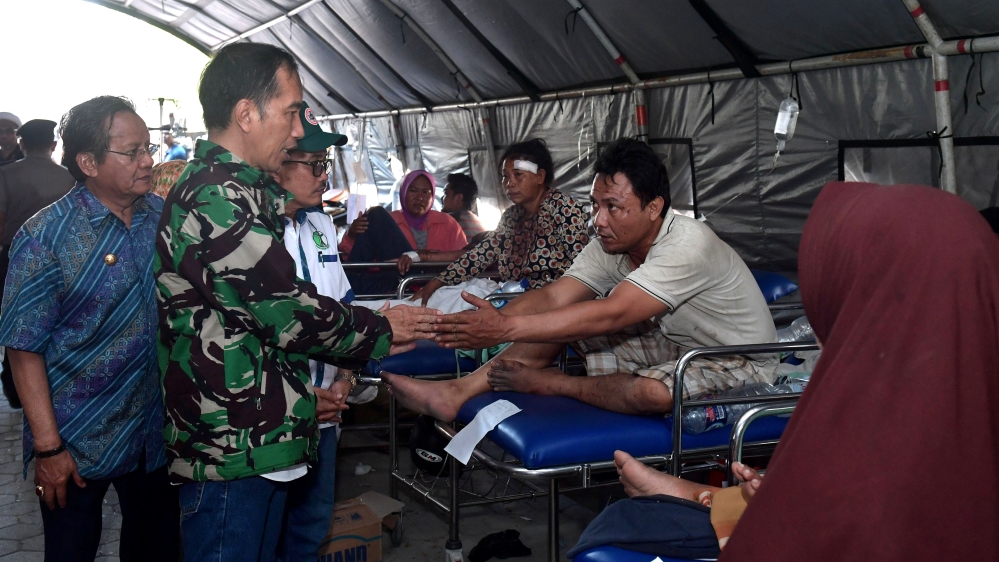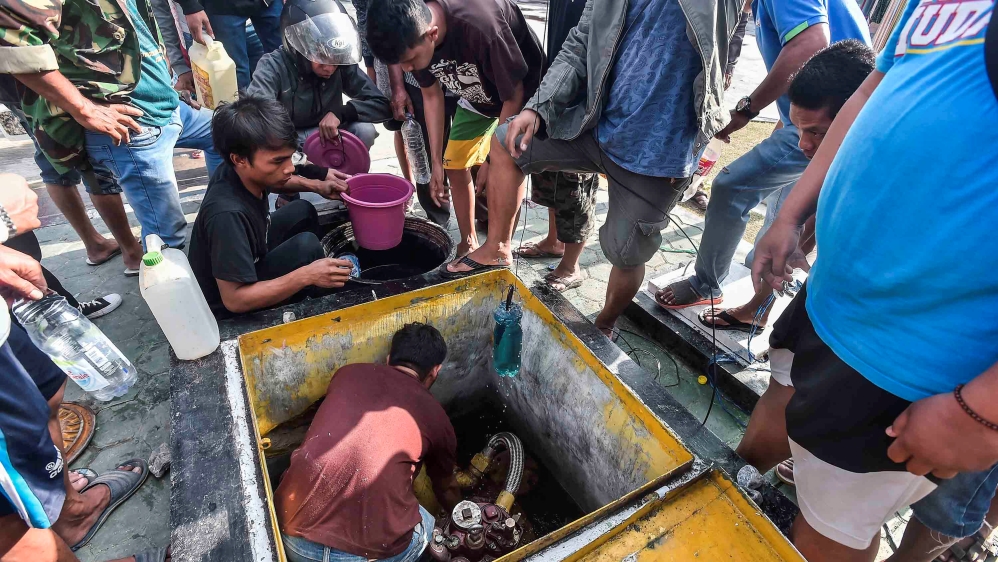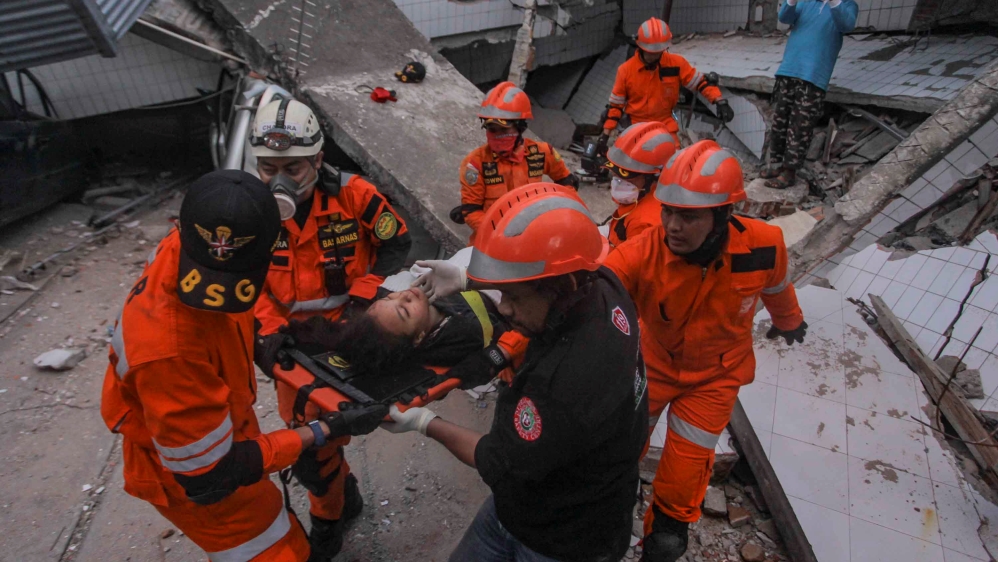Indonesia quake and tsunami: Bodies buried in mass grave
Rescuers in the Indonesia island of Sulawesi are racing against the clock to save those still trapped in the rubble, as volunteers buried bodies in a mass grave following an earthquake and tsunami disaster.
Authorities struggling to deal with the sheer scale of the disaster have appealed for international help.
Four days on, some remote areas have yet to be contacted, medicines are running out and rescuers are struggling with a shortage of heavy equipment to reach desperate victims calling out from the ruins of collapsed buildings.
Authorities are bracing for much worse as reports filter in from outlying areas, in particular, Donggala, a region of 300,000 people north of Palu and closer to the epicentre of the quake.
President Joko Widodo opened the door to the dozens of international aid agencies and NGOs lined up to provide life-saving assistance.
“Last night, President @jokowi authorized us to accept international help for urgent disaster-response & relief,” senior government official Tom Lembong wrote on Twitter, asking rescuers to contact him directly via his account and email.
 |
| Indonesian President Joko Widodo visits people injured by the earthquake and tsunami in Palu, Sulawesi, Indonesia [Antara Foto/Biropers-Kris/via Reuters] |
Officials fear the toll will rise steeply in the coming days and are preparing for the worst.
At Poboya – in the hills above the devastated seaside city of Palu – volunteers dug a 100 metre-long grave to bury the dead, with instructions to prepare for 1,300 victims to be laid to rest.
Authorities are desperate to stave off any disease outbreak caused by decomposing bodies and have announced a 14-day state of emergency.
Twisted wasteland
In Balaroa, a Palu suburb once home to a housing complex, the scale of the damage was apparent. A wasteland of flattened trees, shards of concrete, twisted metal roofing, doorframes and mangled furniture stretched out into the distance.
Dazed groups of people ambled over the wreckage, unclear where or how to start digging. Among them were three men looking for their younger brother.
Up to 60 people are feared to be underneath one Palu hotel alone.
Two survivors have been plucked from the 80-room Hotel Roa-Roa, Indonesia’s search and rescue agency said, and there could still be more alive.
Desperate survivors turned to looting shops for basics like food, water and fuel as police looked on, unwilling or unable to intervene.
“There has been no aid, we need to eat. We don’t have any other choice, we must get food,” one man in Palu told AFP as he filled a basket with goods from a nearby store.
 |
| People collect fuel from a storage tank at a petrol station in Palu, Central Sulawesi [Antara Foto/ Muhammad Adimaja/via Reuters] |
Government officials said some 1,200 inmates fled from at least three prisons in the region.
Many have spent the last days desperately searching for loved ones while dealing with the trauma of the disaster.
One survivor, Adi, was hugging his wife by the beach when the tsunami struck on Friday. He has no idea where she is now, or whether she is alive.
“When the wave came, I lost her,” he said. “I was carried about 50 metres. I couldn’t hold anything,” he said.
Others have centred their search for loved ones around open-air morgues, where the dead lay in the baking sun – waiting to be claimed, waiting to be named.
As dire as the situation in Palu is, it was at least clear. In outlying areas, the fate of thousands is still unknown.
Fuel and rice
Yenni Suryani, of Catholic Relief Services, said devastated infrastructure was hampering rescue efforts.
“Humanitarian groups are struggling to get people into affected areas,” she said. The main airport at Palu was damaged, landslides had cut off key roads while “power is out almost everywhere,” she added.
The state energy company said it was airlifting in 4,000 litres of fuel to help with the rescue effort, while the state logistics agency said it was preparing to send hundreds of tonnes of rice.
Finance Minister Sri Mulyani Indrawati said the government had allocated 560 billion rupiah ($37.58m) for disaster recovery, media reported.
Questions are sure to be asked why warning systems set up after that disaster appear to have failed on Friday, and why more people in coastal areas had not moved to higher ground after a big earthquake, even in the absence of an official warning.
Sutopo Purwo Nugroho, spokesman for the National Disaster Mitigation Agency, told reporters on Sunday none of Indonesia’s tsunami buoys, one type of instrument used to detect the waves, had been operating since 2012. He blamed a decrease in funding.
“Our funding has been going down every year,” Nugroho said.
The meteorological and geophysics agency BMKG issued a tsunami warning after the quake but lifted it 34 minutes later, drawing criticism it had been too hasty.
However, officials estimated the waves had hit while the warning was in force.
 |
| Search and rescue workers evacuate an earthquake and tsunami survivor trapped in a collapsed restaurant in Palu, Central Sulawesi [Antara Foto/Muhammad Adimaja/ via Reuters] |
The head of Indonesia’s investment board said on Twitter Widodo had agreed to accept international help and he would coordinate private sector help from around the world.
Neighbours including Australia, Thailand and China have offered help, while the European Union announced 1.5 million euros ($1.74 million) in immediate aid.
Indonesia, home to 260 million people, is one of the world’s most disaster-prone nations.
It lies on the Pacific “Ring of Fire”, where tectonic plates collide and many of the world’s volcanic eruptions and earthquakes occur.
A massive 2004 quake triggered a tsunami that killed 220,000 throughout the region, including 168,000 in Indonesia.



